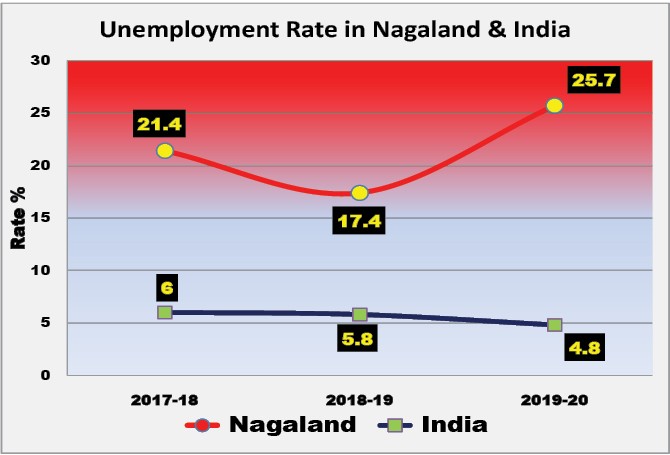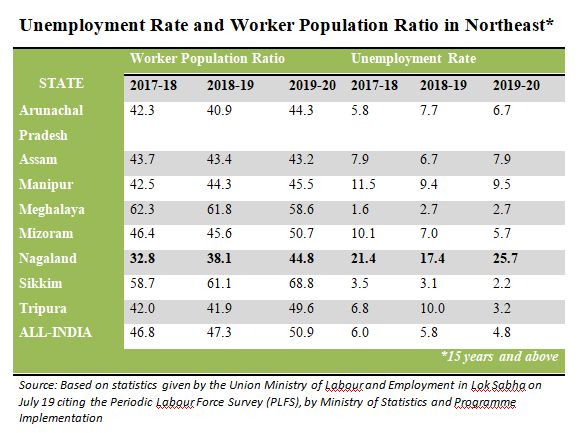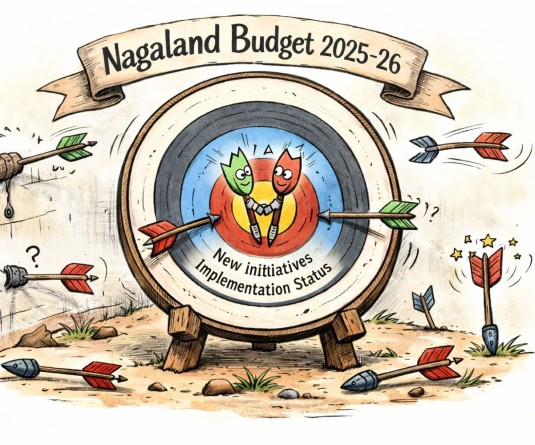Based on data provided by the Union Ministry of Labour and Employment in Rajya Sabha on August 11, citing the Periodic Labour Force Survey (PLFS).

Morung Express News
Dimapur | August 12
After a year’s gap, Nagaland has ‘regained’ the dubious distinction of being the State or Union Territory (UT) with the highest unemployment rate in India.
As per the latest Periodic Labour Force Survey (PLFS) for 2019-20, unemployment rate in Nagaland (15 years and above) was 24.7%, up from 17.4 in 2018-19.
The PLFS data provided by the Union Minister of State for Labour and Employment, Rameswar Teli in the Rajya Sabha on August 11, however, showed a decline in the All-India unemployment rate from 5.8% in 2018-19 to 4.8% in 2020.
Nagaland’s nearest ‘competitor’ was UT of Lakshadweep at 13.7%. Incidentally, at 31.6%, Lakshadweep had highest unemployment rate in India followed by Nagaland during the last survey (2018-19), but it managed to cut down the rate by over 2-fold to 13.7%.

Only two other States or UTs – Kerala (10%) and Andaman & Nicobar Islands (12.6%) reported double digit unemployment rate as per the survey.
All the North East States had low rates with Sikkim at the lowest at 2.2% followed by Meghalaya (2.7) and Tripura (3.2%). The rates in other remaining NE states in ascending orders were- Mizoram (5.7), Arunachal Pradesh (6.7%), Assam (7.9) and Manipur (9.5%).
Accordingly, Worker Population Ratio or the percentage of employed persons in the population was among the lowest in Nagaland at 44.8%. In India, it averaged 50.9%.
Nearly two-third ‘youth’ unemployed
The PLFS (2019-20) released by the Union Ministry of Statistics and Programme Implementation (MOSPI) on July 23 further elucidated the enormity of the unemployment in Nagaland.
According to the survey, percentage of unemployment rate according to usual status (ps+ss) for Nagaland in the age group 15-29 years was an astonishing 70.1% in Nagaland.
During the same period, the All-India rate is shown to be 28.7%.
Meanwhile, even among those counted as employed, nearly two-third or 66.8% gave their work status as “self employed” in Nagaland against the national average of 53.5%.
Percentage of employed getting regular wage or salary in Nagaland was 24.4, while the all-India rate was 22.9%.
A total of 8.8% gave their work status as casual worker in Nagaland against the national average of 23.6.
MoSPI informed that the survey in Nagaland covered 72 villages 576 households and 2425 persons in rural area while 55 blocks, 440 households and 1850 persons were taken as sample for urban area.
What is PLFS?
The PLFS is conducted by the National Statistical Office (NSO) under MOSPI since 2017.
As per the NSO, PLFS was designed with two major objectives for the measurement of employment and unemployment.
First, it measures the labour force participation and employment status in the short time interval of three months for only the urban areas in the Current Weekly Status (CWS); and secondly, it measures labour force estimates on key parameters in both usual status: principal status+ subsidiary status (ps+ss) and CWS for both rural and urban areas.
The principal status considered the activity status “on which a person spent relatively long time (major time criterion) during 365 days preceding the date of survey”, while the subsidiary status considered “activity status in which a person in addition to his/ her usual principal status, performs some economic activity for 30 days or more for the reference period of 365 days preceding the date of survey.”
Accordingly, as both short term and long term economic activities is included usual status, the PLFS in fact might have missed out chronic unemployment and include seasonal and disguised unemployment.






